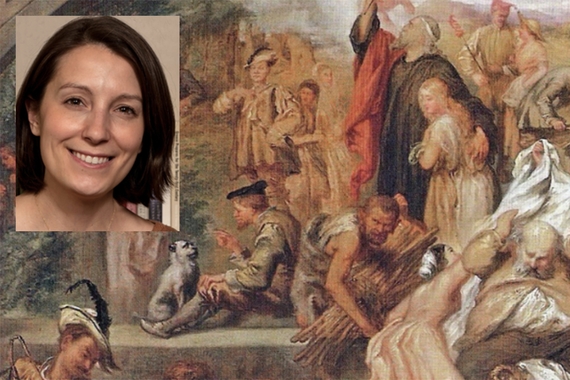Meet Assistant Professor Kathryn Nuernberger
Kathryn Nuernberger, who joined the Creative Writing Program faculty this fall, has published two volumes of poetry. The End of Pink (BOA Editions, 2016) won the James Laughlin Prize from the Academy of American Poets. Her 2017 essay collection Brief Interviews with the Romantic Past (Ohio State University) was awarded the Journal Non/Fiction Prize. She received her PhD from Ohio University and her MFA from Eastern Washington University. Professor Nuernberger taught previously at the University of Central Missouri, where she was the director of Pleides Press. She generously responded to our questions, below.
What writing projects are you working on?
I have a new collection of poems, Rue, forthcoming from BOA in 2020. That book takes as its backbone a sequence of poems about plants that were historically used for birth control and interweaves them with poems about key figures from the history of botany and ecology, as well as more personal narratives about family and love.
I’m also in the thick of working on a collection of lyric nonfiction essays, tentatively titled The Doctrine of Signatures, about historical figures accused of witchcraft. It’s so common right now to claim someone is starting a witch hunt, and I’ve been curious what actual witch trials were like for the accused. Because I have a strong interest in ecology and intersectional feminism, I’ve been particularly interested in the role midwifery and other forms of medieval and early modern engagement with the natural world had on how witches have been imagined.
"I'm interested in the role
midwifery had on how
witches have been imagined."
What is your favorite work to teach?
I really love to teach books I’ve never taught before. While I can certainly be persuaded to play the part of a fancy-pants professorial egghead at the podium about my "areas of expertise," I find teaching so rewarding year after year because I get to remain a perpetual student. Teaching books I don't know inside and out allows me to learn along with my class. And I can justify this pedagogically, because I have found my class discussions are the most dynamic and exciting when the questions I’m asking are not merely rhetorical, but are really the questions I’m trying to think through as a practicing writer as well.
For example, in a nonfiction workshop this semester I’m asking students to read Teju Cole’s Blind Spot, a collection of experimental photo-essays. I’m very excited to have conversations about the relationship between image and text, and how to create cross-genre work that allows both art forms to hold up as equally powerful voices in a piece in which neither mode becomes merely illustrative of the other.
What was the most intriguing piece of writing you've encountered this year?
Shawn Wen’s lyric biography of Marcel Marceau, A Twenty Minute Silence Followed by Applause, completely blew my mind. I spent years trying to write poems about Marcel Marceau and abandoned the project in the end. When I gave up, I concluded his work as a mime was poetry and anything I tried to write about him was merely derivative of an already complete and astonishing work of art. (As you can see, I really am puzzling over this question of how to write in conversation with other art forms without reducing the visual to an illustrative role or making my text little more than a descriptive caption.) In this book Wen found a way to use very short paragraphs, poetic line breaks, and unexpected juxtapositions between critical commentary and descriptions of his performances to infuse her writing with a deeply meditative silence that is akin to the sensations one gets when seeing Marceau make a wave out of the palm of his hand.
I’m teaching this work this semester for the first time too, and I’m really excited to consider with students the ways archival research and cultural commentary, which we often associate with very traditional long-form or journalistic essays, can be used in experimental or genre-blurring ways.
Where did you grow up? Is there anything—food, geography, feeling—you miss?
I grew up in the city of St. Louis, but, thanks to the vagabond lifestyle of an academic combined with how I fell in love with and married a farmer, I have lived for the past 15 years in rural places, on homesteads, or in remote corners of this or that mountain range. Before moving to the Twin Cities, I didn't even realize how much I missed the vibrancy of city neighborhoods—that mixture of getting to overhear everybody’s private business, while also granting each other a lot of anonymity and permission to be as eccentric as you like. Since arriving here this summer I feel as if I’ve gotten to come back home to those roots. On the other hand, I do miss actual roots, as well as the beehive, quail eggs gathered fresh for breakfast, and the strawberry patch. If all goes according to plan, this time next year our front stoop will be a mess of squash blossoms.
What are you most excited about in joining the English faculty at Minnesota?
I have admired books my new colleagues have been publishing for years, so it’s exciting to get to work with them. I’ve also admired the writing that MFA graduates have produced, so I’m especially thrilled to get to devote my time to supporting such talented emerging writers. I love too that this department is in such a vibrant literary community. There’s no end to the fantastic books by local writers I could teach. There are also many career opportunities in editing and publishing, and it’s wonderful to think that the writers I mentor can, if they choose, earn a livelihood in a profession that lets them use their talents while they pursue their passion for writing.
Finally, I think people who can withstand the kinds of winters that require climbing on ladders to shovel the roof (the roof?!?!) and still be friendly when they get down are people I want to know. I just hope I can be stalwart enough under all of my scarves to keep my chin up too.



